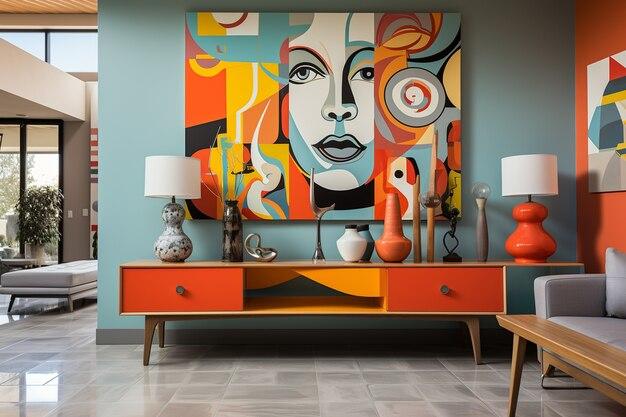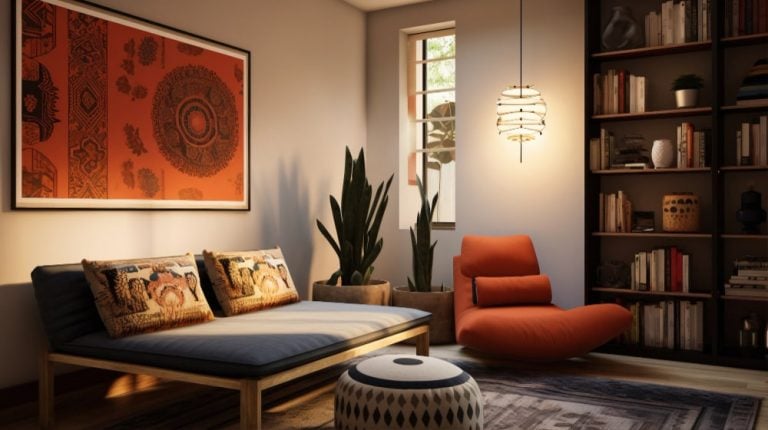Art for interior design: Expert tips on choosing pieces that will elevate your living space

Table of Contents
Home décor has evolved over the past few years – while there was a time when homeowners adhered to strict rules, now, they can freely express themselves, making choices that reflect their personalities. The home should be a nook of escape where you get to relax away from the outside noise. And this is precisely why you should care about what you hang on your wall. Art can generate joyful feelings – we know it from studies that have demonstrated how looking at a beautiful piece of artwork releases dopamine in your brain while allowing for a moment of mindfulness.
Besides, curating a collection of impressive artworks will add character and depth to your living space, elevating and making it feel more welcoming and comfortable. While you may feel tempted to choose artwork solely by relying on your gut, this blog will provide some tips to ensure you find art that works with the overall style of your space. Ready to explore them together? Let’s begin!
Use artwork to create a specific feel in the room
In its essence, art is emotional, so naturally, it will impact the mood of the room you’re decorating. For instance, a holiday-inspired photograph or a beachy photograph will work best in the kitchen or another daytime space, while you should opt for something more intriguing if you’re decorating a space where you spend your evenings. So, the key is to ensure the artwork you choose suits the mood of a specific room. For example, you may want to decorate your bedroom with paintings of sunsets or the sea to promote relaxation, while for the kitchen, you could opt for pictures of food that stimulate your appetite. Check an online website and you’ll undoubtedly find a remarkable piece that resonates with you.
Suppose you have a home office; it is a good idea to opt for art that inspires action (such as a motivational quote) or helps you stay focused and motivated (like a piece that features pics of your ultimate goal).
Pay attention to the color scheme of the room
The truth is that designing a room is an art in itself, as you have to take into account many essential aspects. For instance, when you choose to decorate with artwork, it’s vital to master the concept of color contrast, regardless of the room you’re decorating. This means knowing when to contrast hues and when to complement them to ensure your room will look stunning in the end.
Also, think about what kind of atmosphere you want to achieve in the space: is it harmonious, neutral or dramatic? The palette of the art pieces can contrast, match or redefine the surroundings’ tones through various bespoke combinations that can make the room stand out. If you don’t know what to select, visiting museums or galleries and getting inspiration from the collections’ arrangement can help.
Consider lighting
This may not be an aspect you would immediately consider, but the lighting around the art pieces can completely transform how they are perceived. To display it properly, you should use the right type of lighting, such as halogens, LEDs and incandescent lights. There is no need to light the entire space – you just have to think carefully about how to create a cozy feel in the room and focus on bringing out the artwork’s colors and drawing attention to specific areas.
Remember to keep the pieces away from natural light to prevent colors from fading. Suppose you want to buy art for a bright room in your home; in that case, we recommend opting for prints that are less costly and unlikely to fade easily.
Don’t just stick to paintings and photographs
While you may associate art with a lovely painting or photograph, there are many other kinds of art that you can use to transform your space. For example, you can cover a large wall with a fabric tapestry or place a sculpture in the corner of your room.
Another great idea is to opt for murals, which can take over a space and make it look absolutely
stunning. They make a space look larger and add more depth to it, telling a story through photographs, patterns and abstract images. For example, you can design a mural to promote stillness and harmony in your space by opting for shades like soft greens and blues and patterns that aren’t overwhelming.
Choose pieces that speak to you
We could go on listing the best tips for choosing artwork for your home, but the most valuable advice is to stick to those works of art that move you and inspire you daily. Art is supposed to be felt, so if you fall in love with a piece, make sure to buy it! Also, investing in art to celebrate a special occasion can add more meaning to it.
Choose a piece that marks an important milestone in your life, such as a wedding or a professional goal – looking at it daily will remind you of your achievement and put a smile on your face. At the end of the day, the artwork you display in your home should be an extension of your personality and make you happy, so stick to what resonates with you the most.
Ask an artist for a commission
If you’re looking for a one-of-a-kind piece of art to display in your living space, consider commissioning an artist. Check online art spaces and Instagram to see if any artist’s work draws your interest. Then, try reaching out to them and see if they can create a unique piece for you.
Let them know what you’re looking for, but also don’t forget to ask them about payment details, fees, shipping, or any other essential information. If things work out well, you will have a unique piece of art that truly reflects your personality.
Last words
Adding art to your home is an excellent way to improve its look and feel and its resale value. Not only that, but it will also boost your well-being, spark new ideas, and encourage enhanced capacity for critical thinking, empathy and tolerance. So, what are you waiting for? Get some beautiful pieces and display them in your home to make it shine!






